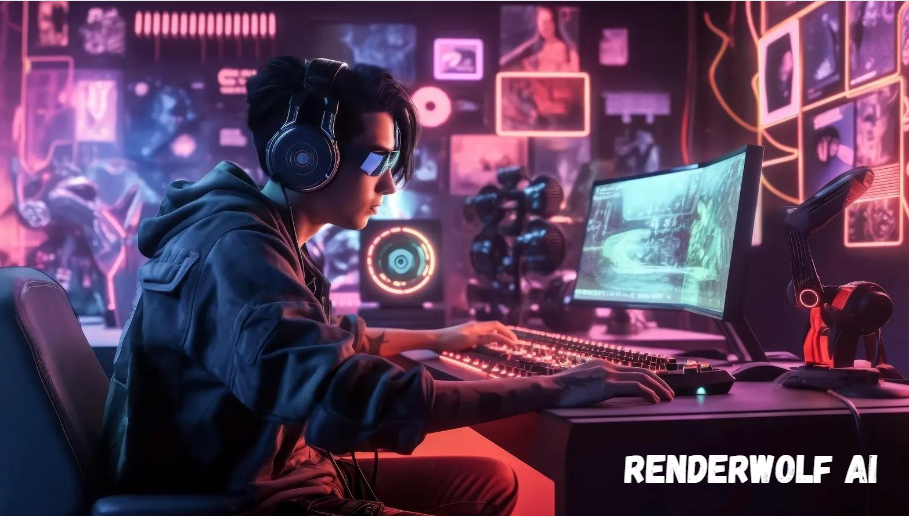Contents
Introduction
In today’s fast-paced game development industry, efficiency and creativity are more important than ever. Studios are constantly looking for ways to optimize their workflows while maintaining high-quality output. This is where Renderwolf AI comes in—a revolutionary tool designed to streamline asset creation, reskinning, and evolution for game studios. This powerful AI-based platform empowers developers by providing an intelligent assistant that can handle complex tasks related to game assets, enabling them to focus more on creativity and gameplay.
As AI-driven tools become more prevalent in the gaming industry, Renderwolf AI stands out by offering advanced features tailored to the needs of developers, both large and small. This article explores the various ways in which Renderwolf AI transforms game development, providing original insights and analyses that go beyond surface-level information. We will also cover how this tool fits into the broader AI revolution in game development, why it’s essential for studios, and what makes it unique.
What is Renderwolf AI?
Renderwolf AI is an AI-powered platform designed to assist game developers in creating, reskinning, and evolving game assets seamlessly. With its advanced AI algorithms, Renderwolf AI allows developers to generate game assets that are not only visually stunning but also optimized for in-game performance. Whether it’s designing new characters, reshaping environments, or adding textures, Renderwolf AI acts as a versatile companion, handling a significant part of the development process with ease.
While traditional game asset creation requires extensive manual work and hours of modeling, texturing, and refining, Renderwolf AI introduces a more dynamic approach. By using machine learning and AI-driven processes, the platform can automate parts of the workflow, allowing developers to create high-quality assets faster and more efficiently.
The Role of AI in Game Development
The incorporation of AI in game development is not a new concept, but its capabilities have drastically evolved over the years. AI tools now assist in areas such as character animation, procedural content generation, and even narrative design. Renderwolf AI takes this a step further by offering a complete package for asset creation, reskinning, and live game updates, making it indispensable for game studios that want to stay competitive in the rapidly changing gaming landscape.
Traditionally, asset creation has been a labor-intensive process requiring skilled artists and designers to craft each element by hand. While this results in highly personalized and unique assets, it also takes time and resources that smaller studios may not have. This is where Renderwolf AI excels by democratizing asset creation, allowing even small teams to produce assets that are on par with larger studios.
How AI Enhances Game Development
- Speed: AI dramatically speeds up the process of asset creation, allowing developers to focus on other important aspects of game design.
- Consistency: AI can maintain a consistent style and quality across various assets, ensuring that the game looks polished and professional.
- Adaptability: AI tools like Renderwolf can adapt to different styles and genres, whether the game is hyper-realistic or more cartoonish.
- Innovation: AI allows for rapid iteration and experimentation, encouraging developers to try new ideas without the risk of wasting resources.
Key Features of Renderwolf AI
1. Asset Creation
One of the core features of Renderwolf AI is its ability to generate game assets from scratch. Game developers can input basic parameters or reference images, and Renderwolf will create detailed 3D models, textures, and animations that fit the desired style. Whether you’re designing a character, a weapon, or an environment, Renderwolf AI streamlines the process by automating much of the laborious work.
This feature is particularly useful for indie developers who may not have a large team of artists at their disposal. By reducing the time and effort required for asset creation, Renderwolf AI allows developers to focus on gameplay mechanics and storytelling, which are essential for the success of any game.
2. Reskinning and Reimagining Assets
Reskinning assets can be a tedious process, especially when a game requires frequent updates or expansions. Renderwolf AI excels in this area by allowing developers to easily reskin and reimagine existing assets. Whether you need to update the look of a character or create new skins for an item, Renderwolf AI simplifies the process by using AI algorithms to apply new textures and visual styles without compromising quality.
This capability is especially valuable for live-service games, where continuous content updates are necessary to keep players engaged. Instead of creating entirely new assets from scratch, developers can use Renderwolf AI to refresh existing ones, saving time and resources.
3. Evolution of Assets
As games evolve over time, so too do the assets within them. Renderwolf AI provides a unique feature that allows for the evolutionary development of assets. This means that assets can be updated, modified, and enhanced as the game progresses, ensuring that they stay relevant and fresh.
Whether you’re looking to improve the visual quality of assets as hardware capabilities improve or want to keep up with changing player preferences, Renderwolf AI provides the flexibility to do so.
4. Live Operations Support
In live-service games, keeping content fresh is critical to player retention. Renderwolf AI supports live operations by enabling developers to quickly create and update in-game assets. The platform can generate new skins, environments, and objects on the fly, allowing studios to respond to player demands, seasonal events, or in-game trends. This makes it an invaluable tool for developers looking to maintain a high level of engagement in their games.
5. Cross-Platform Compatibility
Another key advantage of Renderwolf AI is its cross-platform compatibility. Whether you’re developing for PC, console, or mobile platforms, Renderwolf AI optimizes assets for each medium, ensuring high performance and visual quality. This flexibility is essential in today’s multi-platform gaming world, where studios must cater to various hardware capabilities and player expectations.
Renderwolf AI vs Traditional Asset Creation
While traditional asset creation methods remain valuable, Renderwolf AI introduces several key advantages that make it a game-changer for studios:
- Speed and Efficiency: Renderwolf AI reduces the time required to create high-quality assets by automating repetitive tasks. This allows teams to focus on creativity and innovation.
- Cost-Effective: By minimizing the need for extensive manual labor, Renderwolf AI lowers the overall cost of asset production, making it more accessible to smaller studios with limited budgets.
- Scalability: The platform allows developers to easily scale up their asset production to meet the demands of larger projects or live operations.
- Flexibility: Whether you’re creating a hyper-realistic open-world game or a stylized 2D platformer, Renderwolf AI can adapt to your needs, offering a wide range of customization options.
Potential Drawbacks and Considerations
Despite its numerous benefits, there are some challenges and considerations when integrating Renderwolf AI into a game development workflow:
- Learning Curve: While the platform is designed to be user-friendly, developers may still need time to familiarize themselves with its features and optimize their workflows.
- Creative Limitations: Although AI is improving rapidly, it may not always capture the unique artistic vision that a human designer can provide. In some cases, developers may need to refine AI-generated assets manually.
- Dependence on AI: Over-reliance on AI for asset creation could lead to a lack of originality or creativity in game design. Developers should use Renderwolf AI as a tool to enhance, rather than replace, their creative process.
How Renderwolf AI Fits into the Future of Game Development
As AI technology continues to evolve, platforms like Renderwolf AI are set to become indispensable tools in game development. The ability to automate asset creation, reskinning, and live updates will only become more valuable as the demand for high-quality, regularly updated games grows.
In the future, we can expect AI platforms like Renderwolf AI to expand their capabilities, potentially handling more aspects of game design, such as narrative generation, level design, and even AI-driven gameplay mechanics. However, while AI can undoubtedly enhance efficiency and productivity, it is unlikely to replace the creativity and innovation that human developers bring to the table.
The Rise of AI in Indie Game Development
One of the most significant impacts of AI tools like Renderwolf AI is their ability to level the playing field for indie developers. By reducing the barriers to high-quality asset creation, AI allows smaller studios to compete with larger developers in terms of production value.
This democratization of game development has the potential to foster a new wave of creativity and innovation in the industry, as more developers can bring their ideas to life without being limited by resource constraints.
FAQs about Renderwolf AI
1. What is Renderwolf AI?
Renderwolf AI is an AI-powered platform designed to assist game developers in creating, reskinning, and evolving game assets for various platforms, including PC, console, and mobile.
2. How does Renderwolf AI help game developers?
Renderwolf AI streamlines asset creation by using AI algorithms to automate tasks such as modeling, texturing, and reskinning, enabling developers to focus on more creative aspects of game development.
3. Can Renderwolf AI be used for live-service games?
Yes, Renderwolf AI is ideal for live-service games. It allows developers to quickly generate and update in-game assets to keep content fresh and engaging for players.
4. Is Renderwolf AI compatible with different game development platforms?
Yes, Renderwolf AI is designed to work across multiple platforms, ensuring that assets are optimized for PC, console, and mobile devices.
5. Are there any limitations to using Renderwolf AI?
While Renderwolf AI is a powerful tool, it may require a learning curve, and there may be instances where manual refinement of AI-generated assets is necessary to match a specific artistic vision.
Conclusion
Renderwolf AI represents a significant advancement in game development technology. By automating key aspects of asset creation, reskinning, and evolution, it empowers developers to work faster and more efficiently. Whether you’re a large studio or an indie developer, Renderwolf AI offers the tools needed to produce high-quality game assets with minimal effort.
The future of game development lies in the integration of AI-driven tools like Renderwolf AI, which enhance creativity, reduce costs, and enable innovation. For developers looking to stay competitive in the rapidly evolving gaming landscape, Renderwolf AI is not just an option—it’s a necessity.




